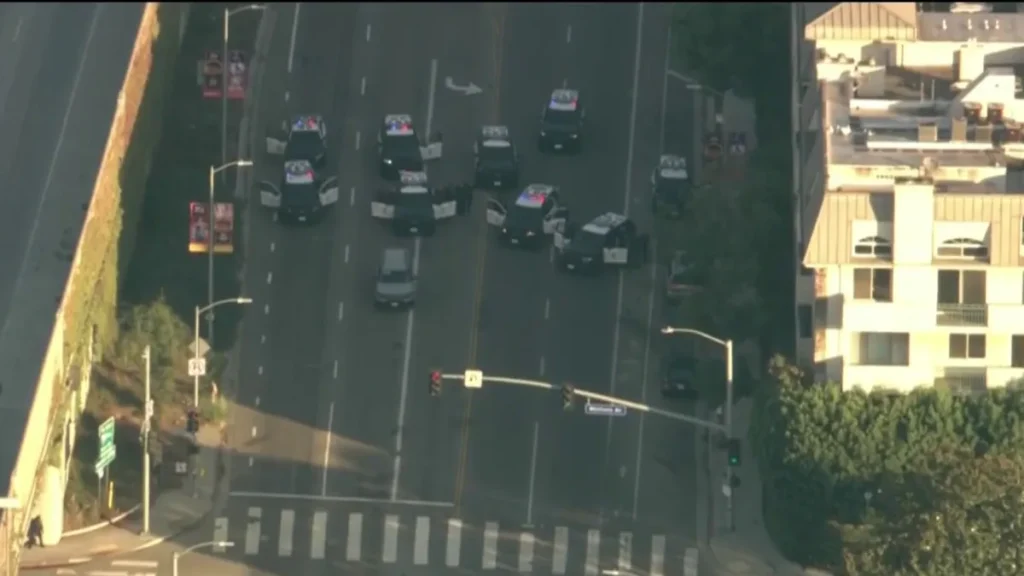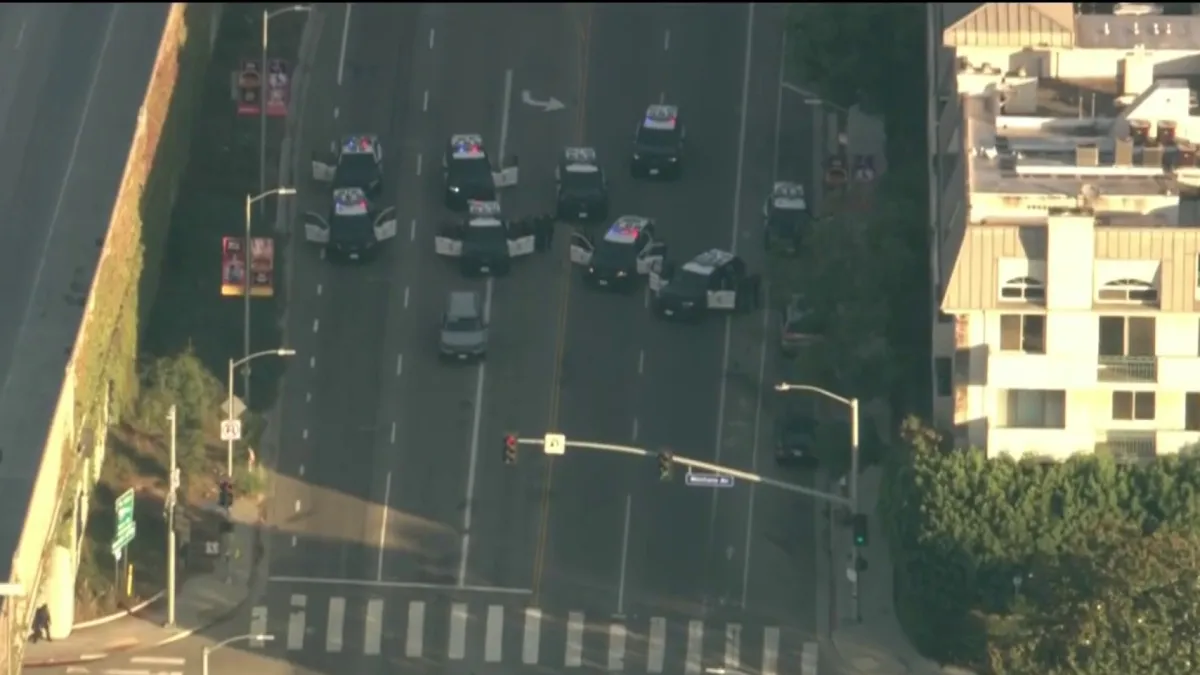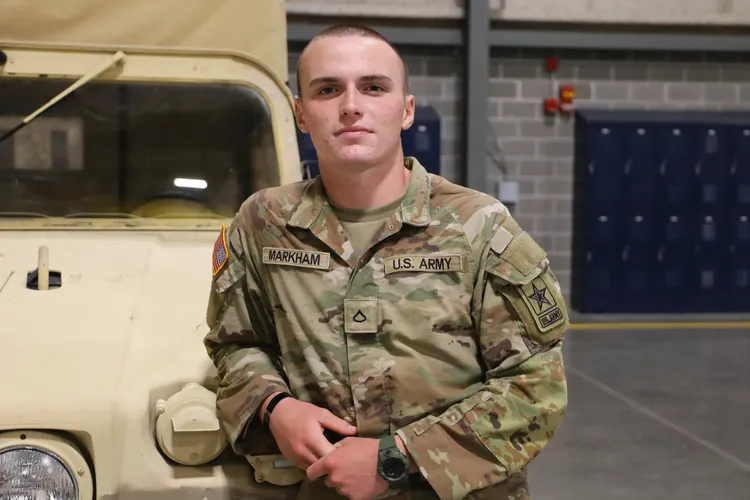The drama began around 6:45 a.m. in the upscale Bel-Air neighborhood, when Los Angeles police received reports of a disturbance involving a woman described as unclothed and possibly armed with a hammer or machete. The suspect, driving a gray Ford Bronco, fled the scene, prompting a brief but intense pursuit that ended just minutes later, around 6:55 a.m., near the intersection of Sepulveda Boulevard and Montana Avenue in Westwood. The woman abruptly stopped her SUV in the middle of the street, refusing to exit, and thus began a standoff that would paralyze the area for hours.
Police quickly established a perimeter, blocking off Sepulveda Boulevard in both directions and causing significant traffic disruptions, including congestion on the nearby southbound 405 Freeway. The sight of the woman, reportedly nude and yelling from the driver’s seat, added an unsettling layer to the unfolding scene, as officers worked to assess the situation and ensure public safety.
Escalation and SWAT Involvement

As the standoff stretched into the morning, the Los Angeles Police Department deployed additional resources to manage the situation. By 10 a.m., three armored vehicles and SWAT officers had arrived, surrounding the Ford Bronco to prevent any potential escape. Aerial footage captured a hammer on the ground near the vehicle, believed to have been thrown out by the suspect during the confrontation, though it remained unclear whether it was connected to the initial disturbance call.
Officers, some wearing gas masks, approached the SUV cautiously, with patrol vehicles and spike strips strategically placed to immobilize the Bronco. The SWAT team’s presence underscored the severity of the situation, as authorities prepared for the possibility of deploying tear gas to resolve the standoff. The woman’s refusal to comply with commands to exit the vehicle heightened tensions, with police maintaining a delicate balance between de-escalation and preparedness for escalation.
A Community Disrupted: Traffic and Public Response
The standoff’s location, at a busy intersection adjacent to the 405 Freeway, caused major delays for commuters. Sepulveda Boulevard, a vital artery in West Los Angeles, was closed in both directions, and drivers were urged to seek alternate routes. The congestion rippled onto the freeway, snarling the morning commute and frustrating residents and workers alike. Overhead, an LAPD helicopter circled alongside media choppers, capturing the scene for live broadcasts that drew widespread attention.
Local residents and passersby watched with a mix of concern and curiosity as the standoff unfolded. The presence of a small dog inside the Bronco, noted by aerial reporters, added a poignant detail to the chaotic scene, raising questions about the woman’s circumstances and state of mind. The incident, occurring in a neighborhood known for its affluence and relative calm, prompted discussions about how such crises emerge and the role of community awareness in addressing them.
Mental Health Support and De-escalation Efforts
Recognizing the potential mental health dimensions of the incident, authorities summoned the LAPD’s Systemwide Mental Response Team to the scene. Mental health professionals were on hand to assist, though it remains unclear whether they were able to make direct contact with the woman during the standoff. Their involvement highlighted a growing emphasis on integrating mental health expertise into police responses to crises, aiming to resolve situations with minimal harm.
The woman’s behavior—described as erratic, with moments of yelling and climbing onto the vehicle’s roof—suggested a possible mental health crisis, prompting authorities to proceed with caution. The deployment of mental health experts reflected a broader effort to address such incidents with empathy, balancing the need for public safety with the well-being of the individual at the center of the standoff.
Resolution and Aftermath
Around 10:45 a.m., after nearly four hours of tension, the standoff reached its conclusion. The woman suddenly exited the Bronco through a window, climbed onto the roof, and then slid down the front windshield before surrendering to officers. Police quickly covered her with a white towel and took her into custody without further incident. The resolution brought relief to the community, though questions lingered about the events leading up to the confrontation.
The woman was transported for evaluation, and authorities have not yet released details about her identity, charges, or the specific circumstances that sparked the initial disturbance. The hammer on the ground and reports of a possible machete suggest the potential for an assault-related investigation, but police have remained tight-lipped as the case remains under review. The small dog in the vehicle was also noted, though its fate was not immediately disclosed.
Reflections on a City’s Challenges
This dramatic standoff in Westwood serves as a sobering reminder of the complexities law enforcement faces in addressing crises that may involve mental health issues, public safety concerns, and unpredictable behavior. The swift response of the LAPD, coupled with the involvement of mental health professionals, reflects evolving strategies for handling such incidents. Yet, the disruption to a busy neighborhood underscores the broader impact of individual crises on entire communities.
As West Los Angeles returns to its usual rhythm, the incident prompts reflection on how cities can better support individuals in distress while maintaining safety for all. For those affected by the traffic delays or shaken by the morning’s events, the standoff is a call to remain vigilant and compassionate, recognizing that behind every headline lies a human story. Resources like the 988 mental health hotline and the Los Angeles County Department of Mental Health’s 24/7 helpline at 800-854-7771 stand ready to assist those in need, offering a lifeline in moments of crisis.





